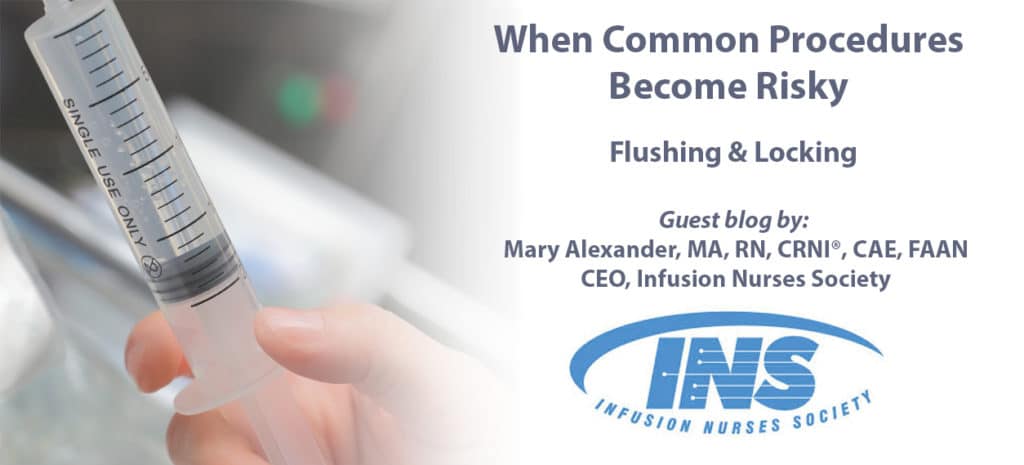Flushing and locking vascular access devices (VADs) are 2 common procedures performed on patients receiving treatment in infusion centers. Flushing is the act of moving fluids, medications, blood, and blood components out of the VAD to ensure treatment delivery and assess for potency. Locking, on the other hand, is the installation of a solution into a VAD to maintain potency during periods of nonuse. While the actual procedure is not complicated and is viewed as easy to do, performing the correct steps and the rationale for doing so may be overlooked.
Because of its invasive nature, infusion therapy is risky. VADs are placed and medications and solutions are administered directly into the bloodstream. Harm, such as a bloodstream infection, may not be detected easily or quickly. As a result, treatment may be delayed.
A practice often seen in infusion centers is to use a 100-mL or a 500-mL bag of solution (eg, 0.9% sodium chloride) as a common source for drawing up flush/lock syringes. Reasons for doing so include convenience (several flushes can be drawn up at one time), cost savings (the cost of a bag of solution tends to be less expensive than a single-dose syringe/vial), and decreasing waste (using and not discarding unused product). While this practice may appear efficient and cost-effective, the opportunity for adverse patient outcomes is substantial.
The practice of using common-source containers to prepare flush syringes is strongly discouraged. Organizations such as the Infusion Nurses Society (INS), the Centers for Disease Control and Prevention, the Association for Professionals in Infection Control and Epidemiology, and the Institute of Safe Medication Practices (ISMP), to name a few, provide evidence-based standards and practice guidelines to ensure safe practice.
Using a common-source bag for flush solutions for multiple patients exposes several risks:
- The practice of preparing the flush solution increases the risk of contamination as a result of multiple entries into the bag.
- Once contaminated, the solution is administered to multiple patients, increasing their risk of infection. If the solution in the bag becomes contaminated, the syringe and the needleless connector may be at risk as well.
- Unsafe injection practices, such as using a single-dose vial/bag for more than 1 patient or reusing syringes to obtain additional doses from the same multiple-dose vial have led to contamination and outbreaks of infectious diseases, such as hepatitis B and hepatitis C.
Respondents to an ISMP survey erroneously suggested that the practice of using a common-source bag for flush solutions was safe because they discarded the solution container after 24 hours.
However, if the bag becomes contaminated, limiting its use to 24 hours will not prevent disease transmission. Moreover, manufacturers label infusion bags as single-dose containers, so they’re intended for single-dose administration, not multiple use, and once opened any unused solution is to be discarded.
To administer safe infusion care, incorporate the following recommendations in clinical practice:
- Never use intravenous (IV) solution bags or bottles as a source for obtaining flush solutions.
- Establish policies and procedures for flushing and locking to standardize care.
- Use single-dose systems, such as single-dose vials or pre-filled syringes, for all VAD flushing and locking.
- Consider using commercially available or pharmacy-prepared pre-filled syringes to reduce the risk of catheter-related bloodstream infection and to save staff time for syringe preparation.
- Use aseptic technique when preparing and administering IV medications, including flushing and locking solutions.
- Assess and validate competency of clinicians for performing flushing and locking procedures when they are hired and on an ongoing basis
INS’ Infusion Therapy Standards of Practice and Policies and Procedures for Infusion Therapy are 2 key resources that address this issue and provide guidance to perform these procedures safely and effectively. Whether our patients in infusion centers are having short-term treatment over days or weeks or long-term therapy for the remainder of their lives, clinicians must be diligent in the care they deliver. We need to minimize risk and optimize therapies so that our patients receive safe quality care. They deserve nothing less!
About the Infusion Nurses Society (INS):
The Infusion Nurses Society (INS), located in Norwood, MA, is an international nonprofit organization representing infusion nurses and all other clinicians who practice infusion therapy. INS is committed to bringing innovative new resources and learning opportunities to the wide range of healthcare professionals involved in the specialty practice of infusion therapy. We are dedicated to advancing the delivery of quality infusion therapy to patients, enhancing the specialty through stringent standards of practice and professional ethics, and promoting research and education in the infusion nursing practice. Learn more about the Infusion Nurses Society by visiting their website at: www.ins1.org/




